Tsukiji Fish Market and Sushi Posted by sasha on Nov 30, 2012 in Culture
When you think of Japan, surely one of the first things that comes to mind is a plate full of sushi (寿司). While your hipster roommate who eats California rolls every weekend may think he’s a resident expert on sushi, there’s actually quite a long history and many traditions associated with it. Although Japan is always credited with inventing sushi, this world famous dish actually comes from Southeast Asia. Many centuries ago, it was created as a way to preserve raw fish by wrapping it in fermented rice. Back then, the rice was discarded and only the fish was eaten. Eventually, it made its way to Japan, where the people actually quite liked the idea of eating raw fish with rice. Eventually, the Japanese started getting creative with this simple recipe, adding seaweed, vinegar, vegetables, and more. The style of sushi known around the world developed in the 1800s – when Tokyo was still called Edo – as an inexpensive fast food that met the demands of a busy population. Today, there are many different styles of sushi, and trained sushi chefs put great emphasis on the appearance; sushi truly is just as much an art form as it is food.
How to make sushi.
If you should find yourself in Tokyo and you want to see the entire process behind Japan’s most popular dish, you’d better begin your day bright and early with a trip out to the Tsukiji fish market (築地市場). As the largest wholesale fish market in the entire world, this place is at its busiest between 5 and 6 in the morning. If you want to land a coveted spot in the designated viewing area, you’ll need to be there even earlier. So far, I’ve been to Tokyo twice, and both times I’ve tired myself out far too much to make it there at the crack of dawn. If you are so lucky as to get a spot, though, you’ll be able to take in the madness of the morning auction. Even if you arrive a bit later, you’ll still find the place buzzing with activity, as countless vendors package the day’s haul and sell it off. After about half an hour of dodging carts, walking through puddles, and trying to avoid fish guts, we decided it would be best to get out of the way and go check out the next stop in the journey of all that fresh fish.
Around the market, you’ll find a handful of local restaurants that specialize in variety plates of sushi. Although raw fish, rice, wasabi, and tea were a stark contrast to our usual breakfast of eggs, bacon, bagels, and coffee, we decided to try the 14-piece sushi sampler for breakfast. Inside, we were welcomed with a big smile from the chef, who diligently prepared the individual pieces of sushi for us as we sat at the bar. One by one, the tasty little morsels kept coming up – tuna, octopus, eel, salmon, and some mysterious looking things that neither of us could identify. Feeling adventurous, we even tried the sea urchin and fish eggs, which almost came back up onto the plate. Hey, at least we tried. While it definitely won’t become my new breakfast routine, enjoying a wide variety of fresh sushi just around the corner from where the fish was actually hauled in was a great experience and definitely stands out amongst both of my visits to Japan.
http://www.youtube.com/watch?v=yuhu4QZJZyw
Anthony Bourdain tries “the best sushi in the world” in Tokyo.
If you don’t have time to get over to the fish market, never fear, as you’ll find sushi just about everywhere you look. When you find yourself strapped for time and looking for a quick bite to eat, just drop into one of Tokyo’s many conveyor belt sushi restaurants. Here, customers take a seat along the bar and choose from a variety of items that constantly rotate around the room. You’ll find different styles of sushi, sashimi, vegetables, soup, and more, along with ample supplies of ginger (生姜), soy sauce (醤油), and wasabi (わさび). When it comes time to pay the bill, the waiter will simply look at the different colors of your plates, as each color represents a specific price. No need to worry about language barriers or struggling through a menu that you can’t understand!
However you choose to get your sushi, you won’t be disappointed. Japanese people take great pride in their culinary arts, as they should, seeing as how we were never once let down by a dining experience in the Land of the Rising Sun. In an age where fast food is so prevalent, it’s refreshing to see that Japanese still pride themselves in churning out beautiful, healthy, and delicious sushi, even if it’s done in a matter of minutes to satisfy the needs of a busy metropolis like Tokyo. As an American living abroad, people always associate me and my country with sloppy, unhealthy, greasy food like McDonald’s and KFC. It’s at these times that I have a bit of cultural envy for the Japanese – I’d rather be known for a fresh piece of salmon sashimi dipped in soy sauce than a dirty piece of fried chicken soaked in mayonnaise. If the sushi restaurants popping up all over America (and the rest of the world, for that matter) are any indication, though, maybe someday a plate of sushi will be just as ubiquitous as the golden arches across the world.

Build vocabulary, practice pronunciation, and more with Transparent Language Online. Available anytime, anywhere, on any device.



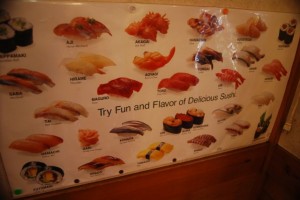
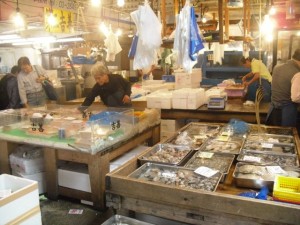
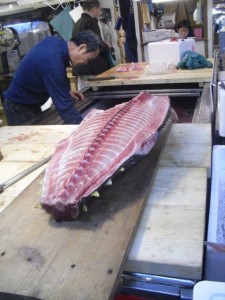
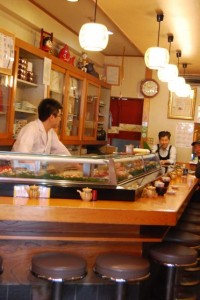
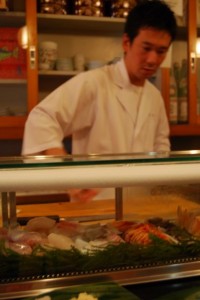
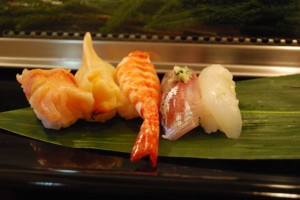
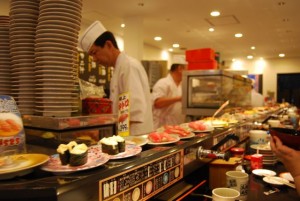

Comments:
Tim Upham:
Seafood was not only popular in Japan, because it is an island nation. But also was popular, because in Buddhism it was not looked upon favorably, to eat warm blooded creatures. So this is a later addition to Japanese culture. Because the Ainu greatly enjoyed their bear meat during Iomante, and hunted the sika deer in massive numbers during the fall. This is when the venison had the most fat on it, and it was stored as a winter staple.